Kytherian Association of Australia - The Founding Fathers
Edited by Esther Calligeros 2/12/2020
The Kytherian Association of Australia - then called the Kytherian Brotherhood - held its inaugural meeting at the Marathon Café in Sydney in 1922. Since then it has worked tirelessly to promote Kytherian culture and has successfully inspired generations of Kytherian-Australians to appreciate the heritage of their parents and grandparents.
Detailed History, The Kytherian Association of Australia, Sydney
Cosmas Cassimatis and the founding of the Kytherian Brotherhood of Australia, 1922
On 12 May 1921, Cosmas Jacob Cassimatis floated the idea of a Kytherian Brotherhood with his friend Theo Crithary at Theo’s Marathon Cafe in Darlinghurst. Exactly one year later, on 12 May, 1922, at Cosmas’ Canberra Cafe at Central, they drew up a letter of intent, encapsulating Cosmas’ basic idea. With that document, the Kytherian Brotherhood came into existence, and it formed the first page of the first Minute Book of the Brotherhood.
In August, 1922, all Kytherians were invited to attend the first meeting. There were some 30 women and 50 men present. At this meeting the first Committee was formed, and office bearers were elected. The first Committee consisted of:
Cosmas J. Cassimatis.........President
Peter Minoukos..................Vice President
Bill Feros.............................Secretary
Nick Marcello.....................Treasurer
Cosmas Andronicus
Theo Crithary
Bretos Margetis
John Psaltis
The Constitution was further developed, and incorporated Cosmas’ ideas. In 1936 the Brotherhood was formed into a company, and the original Constitution formed part of the Articles of Association. To this day, very little of this Constitution has been altered.
From the beginning, Cosmas felt that the Brotherhood should honour the two Patron Saints of Kythera, Theodore and Panagia Myrtidiotissa, and the Martyr, Saint Elesa. This forms a major part of our Constitution.
Throughout his life, Cosmas, the son of a priest, and someone who had wanted also to study Theology, was a major influence on the Greek Orthodox Community, then centred on Agia Triada in Surry Hills. He served for a short time as President of the Greek Community, and this, combined with his position as President of the Kytherian Brotherhood of Australia, meant that he was seen as a father figure by many of the young arrivals, even to the extent of them asking for his permission to marry. His business judgement was highly respected.
Cosmas was born in Kato Livadi, Kythera, in 1889, and first came to Australia in 1908. He returned to Greece briefly, served in the Balkan Wars, and returned in 1914. After several business ventures he purchased a cafe, the Canberra Cafe in Oxford Street, Taylor Square, with cousin Nick Cassimatis and four other partners - Nick Travasaros, Stamati Marcello, Stratis Tzannes and John Megaloconomos. Cousin Nick was to later sell out and open a store in Park Street, but the descendants of all the others continue to hold the property in partnership to this day, making it one of the longest partnerships in Australian Greek history.
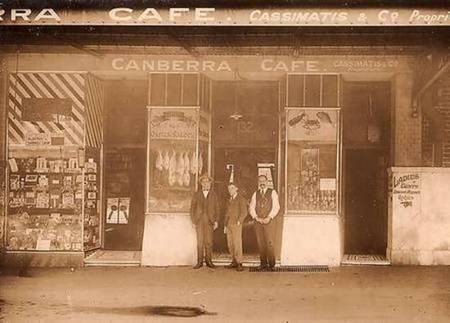
Canberra Cafe. Cosmas Cassimatis is standing on the right.
This Canberra Cafe in Oxford Street became the meeting place for the newly formed Kytherian Brotherhood of Australia. It was decided that a meeting would be held once a year, and Kytherians would travel from all the country towns to meet in Sydney on the proposed date. Although picnic days were also held, it was not until larger numbers of women arrived from Kythera that more social functions were organised.
Cosmas, who was naturalised in 1925 (although he had originally intended to stay in Australia for only a few years) returned to Kythera only once more, and this time it was to marry. In 1929, on the advice of his father, he married Marica Lazerreti, of Lazerretianiki (Kato Livadi). This marriage, which was an extremely happy one, produced three children, Katina, Jack and Emmanuel.
Marica, born in 1904, had served as the Secretary of the Kytherian Community. In this role, being a literate woman, having completed her schooling which was unusual for her time, she was often called upon to read letters arriving from Australia or other countries to which Kytherians had emigrated, and also to write lefters for those on the island.
Marica returned to Kythera for a visit with son Jack in 1969 and was met at the docks with banners saying ‘Welcome back Marica’. It took about 4 hours to walk 100 metres, such was the excitement from the people who remembered her with much deep affection.
In Australia, Marica, a very devout woman, proved to be a mother figure for many of the young women, cut off from their mothers and grandmothers whom they had left behind in Greece. She gave advice on cooking, on how to get on in Australia, and on many other matters. Their house, in Kensington, hosted many wedding receptions for Kytherians. Marica supported Cosmas in his role as a leader amongst his fellow Greeks; a role which meant being called upon to accompany Prince Phillip, then a prince of Greece, on his tour of Australia.
In the early days, Greeks believed that Australians had much to teach them, and they aimed to assimilate, while at the same time holding on to what they felt was worthwhile in their own culture. According to son, Emmanuel, these early Kytherians "had a very high moral code, their principles were second to none, and their good name was of paramount importance."
These ideas, that we are guests and should not forget it, and that we should never give anyone reason to say anything bad about us, have influenced all the subsequent generations of Kytherians born in Australia (although we are no longer ‘guests’). Eighty years on, the Kytherian Association of Australia (formerly the Brotherhood) can rightly feel proud of its roots, and the man, Cosmas Jacob Cassimatis, who was the force behind the Association’s formation.
By Ann Coward, from information supplied by Emmanuel Cassimatis
First published in Programme, 80th Anniversary Debutante Ball, 2002, Kytherian Association of Australia, pp. 36-37.
Also in the Vema, August 2002. View / download a copy here:
VEMA 2002 08 ENG p 30.pdf
Eventful years, 1922-1932, Greek and World historical context
The Kytherian Association was born in the same year as the "Catastrophe" of Asia Minor - the year that the "great idea" - Greece's reclamation of Constantinople collapsed. Greeks were repatriated en masse from areas occupied by the Turks. In the ensuring turmoil, Greece, a country of five million people, was transformed by the sudden influx of one and half million refugees. In Athens, in the autumn of 1923, three people in every ten in the streets had arrived there via Asia Minor. It would be a number of decades before Greece would recover its equilibrium.
Seven years later, the longest, most widespread, and deepest depression of the 20th century began. The timing of the Great Depression varied across nations, but in most countries it started in about 1929 and lasted until the late 1930s or early 1940s.
Most of the Executive of the Kytherian Association of Australia were small businessmen, members of the "shop-keeping" fraternity. They were most at risk during times of economic downturn. As we will find out shortly, some founding fathers like John Psaltis would go guarantors for a loan which would have seemed low risk in the years 1922-1927, but which had a catastrophic influence on their lives in 1928-1929. Others like Bretos Margetis, recently "over-capitalised" by purchasing cinema's in Liverpool, as well as running an inner city restaurant, would feel the full brunt of the depression. It was a credit to the resilience of Kytherian businessmen, that many of them, as well as the Kytherian Association of Australia, managed to survive.
The first decade of the history of the Kytherian Association of Australia, has to be viewed in the context of these two tumultuous events.
If the sumptuous nature of the Kytherian and Hellenic Balls that were held in the latter years of the 1930's is any guage, the Kytherians seem to have rebounded from the effects of the Depression better than most groups in Australian society.
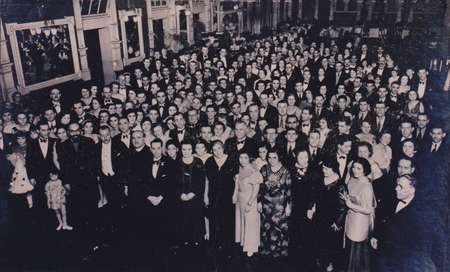
The Kytherian Ball has a long tradition. This photograph was taken at the 1938 Ball, which was held at the Mark Foys Empress Ballroom (entrance Castlereagh Street, Sydney).
Kytherian Annual Supper Dance. 30th April, 1940
The Grecian Cabaret Ball in 1939 Orange, NSW, Australia
The relationship between the Executive of the Kytherian Association of Australia, and Committees involved with the Greek Orthodox Church
"Cross-overs" of Committees
Civic Leaders of the Kytherian Community were also prominent in the Greek Orthodox Church Committee's. in particular in helping to establish the first Greek Orthodox Church in Australia, Ayia Triatha at Surry Hills.
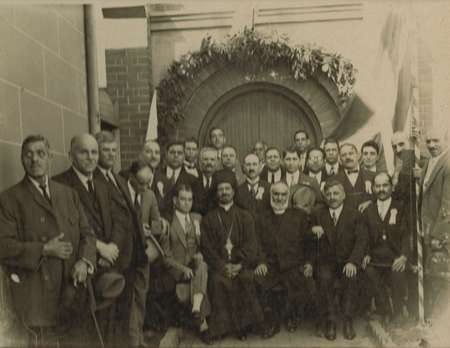
Two of the Founding Fathers of the Kytherian Association of Australia are present in this photograph. The gentleman seated on the far right, is first President Cosmas J Cassimamatis, and the gentleman standing behind the priest on the right, holding his hat, is Bretos Margetis.
It would be great to identify all those present in the photographs. Can you help identify others in the group?
The original photo is now housed in the archive of the Kytherian Association of Australia, Library, Level 1, 28 King Street, Rockdale.
For more on the Eastern Orthodox Church in Australia:
The Eastern Orthodox Church in Australia. From the BIMPR series
History of the Greek Orthodox Church in Australia
Peter Minoukos, first Vice-President
Peter Minoukos's brother, Theodoros Ioannis Minoukas, and his unamed sister, feature on pages 228-229 of Life in Australia. Theodoros established a shop in the township of Kyogle in NSW in 1910.
View / Download a .pdf of those pages here:
LIA pp 228-229 Theodoros I Minoukas.pdf
Bretos Margetis
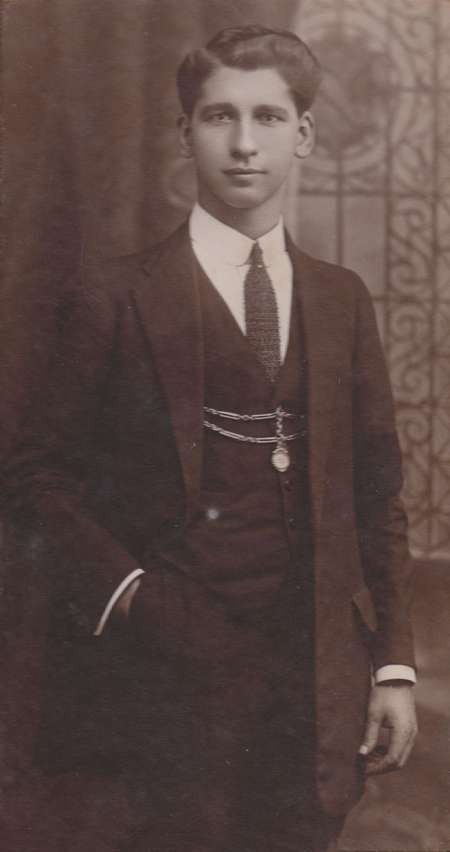
Bretos was one of the eight Founding Fathers of the Kytherian Brotherhood of Australia (now called the Kytherian Association), in 1922. He did not serve in the second administration (1924-1926), but in the third administration, (1926-1928), he took on the executive role of Secretary.
Bretos was born on 24 Nov 1889. He landed in Australia on 5 Dec 1903 per the ‘Orizaba.’
Arrivals Australia, 1903
He features in the book Life in Australia, on page 201.
Download a .pdf of page 201, here:
LIA_English_p201.pdf
His name is spelt Vretos in Life in Australia but I he always spelt it Bretos.
He was married in 1925 at the Agia Triatha Church Bourke St Sydney, to Theodora Lianos.
Wedding photographs
Bretos Margetis and Theodora Lianos outside Agia Triatha, Sydney
Bretos Margetis and Theodora Lianos outside Agia Triatha, Sydney
Wedding party photograph, Wedding of Bretos Margetis and Theodora Lianos
Studio portrait of Theodora Lianos on her wedding day
Studio portrait of Theodora Lianos on her wedding day, with mirror image
Shop of Bretos Margetis at 615 George St Sydney
Charles Andronicus (Kosmas Andronikos)
Kosmas, known as Charles Andronicus, served on the first founding Committee from 1922-1924. He did not serve in the subsequent term, but returned in 1926-1928, to serve as Treasurer.
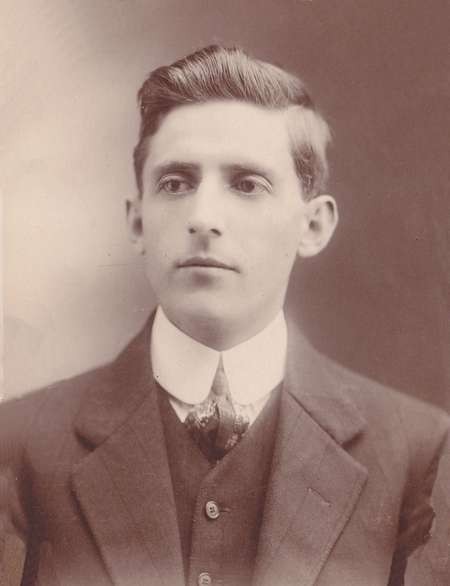
Andronicus - The family that established a coffee dynasty.
From, Hugh Gilchrist. Australians and Greeks. Vol I: The Early Years. p. 203.
"...From the Kytherian village of Mylopotamos came seven Andronikos (the surname spelt "Andronicus") brothers, of whom four built up a tea, coffee and chocolate business which, eighty years later, is still eminent in the beverage and confectionery field. Their interest in tea and coffee and in emigration is said to have been aroused by an uncle, Dr Karydis, a medical officer of the Suez Canal Company.
Nikolaos, the first to arrive (in 1897), acquired a shop in Tamworth, and in 1908 married Antigoni, a daughter of the Reverend Serafeim Phocas. He was followed by brothers Minas (Mick), who opened a cafe in West Maitland, Kosmas (Charles) and Emmanouil, who opened a shop in Tamworth.
In 1907 Kosmas (known as "Charles") and Emmanuel Andronicus opened a small shop at 127 York Street in Sydney. Charles visited Calcutta and Colombo and brought back chests of tea and coffee, and fish-frying oil and crockery and fancy goods. Emmanuel, armed with samples, travelled by train around New South Wales, seeking orders from Greek and other shop-keepers for tea, coffee, olive oil, sauces, crockery, cutlery and other items, advancing credit where appropriate.
As their business grew, Charles became a kind of unofficial arbitrator in disputes between up-country Greeks, and a mouth-piece for their grievances.
Ioannis, the youngest brother, after a month at Port Said with his uncle Dr Karydis, arrived in Sydney when he was 13 and lived with his brother Mick in West Maitland, where, for lack of English, he had difficulty in studying at school. When
Mick sold his cafe and moved to Sydney, Ioannis went to brother Nicholas in Tamworth, where he had a happy year at the local convent school.
Nicholas meanwhile had taken in as partner another brother, George, who had landed in Sydney in 1907.
In 1910 Charles, Mick and Emmanuel, joined by John, moved Andronicus Brothers from York Street to 197 George Street, where three of them lived in rooms over the shop. Young John was instructed in the techniques of tea and coffee blending and of packing goods for dispatch.
Mick returned to Greece and in 1912 Nicholas and Antigoni settled in Sydney, where Nicholas managed the Marathon Cafe at 72 Oxford Street. George Andronicus then joined forces with a cousin, Georgios Potiris (who had come to Australia in 1902 and had worked at Barraba), and bought the large Apsley Hotel in Walcha, which they managed until 1919.
Now 19, John Andronicus helped Emmanuel with up-country sales, working the towns near the Queensland border. With his friends John and Antony Notaras he went fishing and shooting at weekends, and on one such excursion his rifle accidentally discharged. The bullet passed close to his heart but John Notaras got him onto a horse-cart and into Grafton, where Dr Page (later Sir Earle Page of the Country Party) operated on him and saved his life; and after three more operations in Sydney he recovered.
After early difficulties, and by prodigious efforts, Andronicus Brothers prospered and its partners played important parts in the Greek community.
Other Andronicus relatives also arrived in Australia before 1915, including Stylianos, who partnered his brother-in-law Panayiotis Kominos in shops in Lismore and Muswellbrook and in a cattle property, and Kharalambos, who had the Club Cafe in Toowoomba.
Another cousin, Mikhail Potiris, who, like his brother George had been persuaded by an Andronicus to leave Mylopotamos for Australia, worked with George Potiris in Barraba and later had a shop in Queanbeyan, but sold it in 1914 and eventually became the second Australian Greek to graduate in medicine".
Kosmas (Charles) was, with Emmanuel and Georgios E Kentavros one of the 3 co-authors of Life in Australia.The entry on the Andronicus brothers in Life in Australia is extensive.
View / Download a copy of the entry on the Andronicus brothers, here:
LIA English 128-130.pdf
The Life in Australia entry refers to the Andronicus family as possessing "considerable property in the form of shops, whilst their trading house might be better described as a house of trust and hospitality. From all corners of Australia, Greeks, and even Australians, turn to the Andronicus brothers for any information or any affair.
Their trading house is the centre of Hellenism, particularly for Kytherians. Just as their trading house should be named The House of Confidence, so should the General Manager, Mr Kosmas Andronicus, be named the guiding intelligence of most Greeks of New South Wales. Mr Andronicus was by nature intended for the priesthood, rather than for a career in commerce. He is young, a linguist, possesses an encyclopaedic education, as well as considerable social grace.
Beloved by all, Mr Kosmas Andronicus comes across as compassionate, magnanimous and the keen supporter of anybody who has suffered injustice. He spreads encouragement through his valuable advice to the many who have suffered some setback or failed in some enterprise.
Anyone who has ever met Mr Andronicus finds him with a sweet smile upon his lips. He is small in stature and slightly built, but his mind, heart and will are great, a man of progress who is fully aware of the laws of humanity and the rules of society. In the case of so great a man, even if whole pages were to be written about Kosmas Andronicus, they would still not seem sufficient".
Andronicus brothers store, Sydney, 197 George Street, Sydney
John Andronicus. A Kytherian facilitates the shift from tea to coffee drinking in Australia
The Perfect Cup; The Story of Coffee, by Keith Dunstan and Sue Fairlie-Cuninghame.
Published by ‘Andronicus of Castle Hill’ 1989
Charles Andronicus interviewed by Don Baker
John Psaltis & Theo Crithary
John James Psaltis who was born on 24 Oct1882 in Mitata, Kythera, and his brother, Nick James Psaltis, was born 18 Feb 1891. They arrived in Australia on the 2nd & 3rd April, 1908 aboard the ‘Omrah’. (They disembarked on separate days).
The brothers Theodoros (Theo) and Panayiotis (Peter) Kritharis, known as Crithary in Australia, migrated to Australia, on separate ships, in 1908. They were sons of the long standing and much loved "Pappa Vangelli" (Evangelos Ieros Kritharis) of Karavas, and Stamatina (nee Panaretos), of Potamos.
Theo Angelo , who was b. 30 Aug 1893 in Karavas, landed on 1 Jul 1908 per ‘Sedlitz.’ (Returned in 1922 & 1933)
Peter Angelo Crithary who was b. 26 Oct1895 in Karavas, landed 17 Dec 1908 per ‘Roon.’
Theo & Peter as young men, soon after their arrival in Australia
Pappa Vangelli's family consisted of 3 boys - Theodoros, Panagiotis, Haralambos and 5 girls - Georgitsa (Comma), Kanella (Moulos), Maria (Georgopoulos), Kalomera (Zantiotis) and Louisa (Psaltis). Louisa was born on 25 September, 1906 in the village of Karavas. She went to school in Karavas for 5 years until 1918; in those years there were some 40 girls and 60 boys in separate schools in the town.
Louisa left Kythera on 14 March 1922 at the age of 15 years to come to Australia with her brother Theo, who had returned to Kythera for a visit. Originally, Theo was to bring Kalomera (an older sister) with him back to Australia, but Kalomera had become engaged to Sarandos Zantiotis and did not want to leave Kythera. Instead, Louisa (with the passport of her sister) came with Theo to Australia, arriving in June 1922.
Soon after their arrival, Theo took Louisa with him to his cafe the Marathon Cafe, (at 72 Oxford St., Sydney) for the first meeting of the Kytherian Brotherhood. As we have already discovered, the organisers of this meeting included Cosmas Cassimatis (who had the Canberra Cafe in Oxford St., Darlinghurst), Theo Crithary, Vassilis Feros, Peter Minoukas and Paul Calopedes (with later help from people such as Cosmas Andronicus, Bretos Margetis, and Nicholas Marcellos).
At this meeting, there were some 30 women and 50 men. It was here that Louisa met Nicholas James Psaltis, a prominent business man, and became engaged to him on her sixth birthday, 25 September, 1922. They were married on 21 January, 1923 at the Holy Trinity Greek Orthodox Church, in Bourke St., Surry Hills. Thus two of the founding fathers of the Kytherian Association of Australia, Theo Crithary and John Psaltis, became "symetheri".
Nick and Louisa had one child Anne. Anne surrounded by family and freinds
John Psaltis, Nick's brother served on the first Committee 1922-1924 of the Kytherian Brotherhood / Association, but did not serve another term.
John and his brother Nick, ran the Psaltis Brothers Cafe, in Kings Cross for some years. They sold the cafe and the building in 1928. Soon after, the brothers lost a fortune, by 1920's standards, (10,000 pounds) by going guarantors for Kytherian friends to set up a business. The business went bankrupt, leaving Nick and John with a very hefty debt.
It would be advantageous if we could obtain a photograph of John Psaltis, and a more "detailed" life history for him. Do you possess such a photograph, or knowledge of his life history?
Theo Crithary
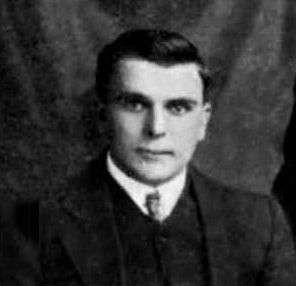
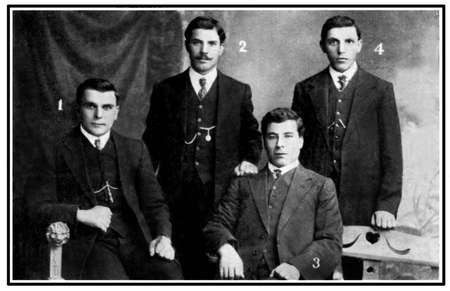
1) Theodoros Kritharis, (Theo Crithary) 2) Theodoros Tzortzopoulos, (theo Poulos) 3) Minas Tzortzopoulos, (Mick Poulos) 4) Panagiotis Kritharis (Peter Crithary)
View / download a copy of page 147 here:
LIA English 147.pdf
Two splendid and extremely profitable shops, located in the city of Glenn Innes, in New South Wales, do worthy honour to the Greek name. The shops, both of which stand on the central streets of the city, are run by the young and ambitious brothers Messrs. Theodoros and Panayiotis Kritharis, sons of Evangelos Kritharis, and their cousins, Messrs. Minas (Mick) and Theodoros (Theo) Tzortzopoulos (Poulos), all of whom hail from the island of Kythera.
All of them belong to the small group of Greeks who, within a short period since their arrival in Australia, have achieved sudden and remarkable progress. Moreover, these distinguished members of the Greek race are shareholders in the motor transport company operating between Inverell and Glen Innes. Working, as they do, in an extraordinary spirit of harmony and love, they have managed, within a short time, to gain a place among the most well-established Greeks in Australia. Mr Theodoros Kritharis also happens to have made donations to the hospitals of Glenn Innes.
Theo Crithary standing outside his shop in Glen Innes
Peter McCarthy, Kytherian historian notes that The Peters & Co proprietors, Leonidas Gengos, Nicholas P. Aroney, Spiro Coroneo, Theo Crithary, Theo Georgopoulo, Peter Crithary, and Michael Georgopoulo were registered as the owners of the shop in the photograph from 20 April 1911 until the business was taken over by Peter Cosmas (Kotsifos) Sourry and Alexander Coroneo 25 October 1916.
Peter Crithary moved to Warialda in 1916 and Leonidas Gengos moved to Sydney in the same year.
Later Theo established a food supply firm named Embros - "Forward". He claimed to be the first importer of ouzo into Australia, selling it to several hotels, and he also sold Greek olives to Woolworths.
Theo Crithary was a literary and philosophical man. In 1923 he tried, without success, to bring together, the disunited Greeks of Sydney.
Mr Theo Crithary solved the puzzle
Theo Crithary, later in life, with wife Helene
Theo Crithary, even later in life
Peter Crithary with his father
Nick Marcello

Nick G Marcello was born on the 15th August,1880, in Potamos, Kythera. He emigrated to Australia on the 6th November,1907 on the ‘Bremen.’
As we learnt earlier on in this entry Stamati Marcello (brother?) was a partner with Cosmas Cassimatis, (first President), and several others including, Nick Cassimatis, Nick Travasaros, Stratis Tzannes and John Megaloconomos in the Canberra Cafe in Oxford Street, Taylor Square, Sydney.
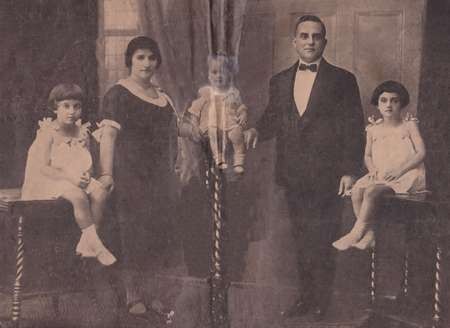
Nick G Marcello and his family.
He held the position of Treasurer in the Foundation Committee of 1922-1924. He was not a member of subsequent Kytherian Brotherhood / Association Committee's.
Peter Minoukos
Peter John Minucos (spelling on the passenger list), was born 25th February, 1895, in Aroniadika, Kythera. He arrived in Australia on the 6th Aug1908 on the German boat ‘Roon.’
He served as Vice-President on the Foundation Committee of 1922-1924. He returned to serve on the Committee almost two decades later, in 1940-1944.
Farewell party for Bishop Nikodimos, 1938
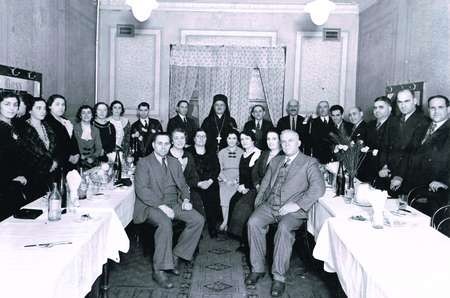
The function was held in the upstairs area of the Sydney Cafe, 735 George Street, which was then owned by Emmanuel Mavromatis, who is depicted in the photograph.
I have numbered the attendees to this function in another photograph. The numbers in this entry refer to the numbers used there.
The function was held in the upstairs area of the Sydney Cafe, 735 George Street, which was then owned by Emmanuel Mavromatis, who is depicted in the photograph.
Now that we have named all of the attendees, can you tell us more about their lives? By some chance, are you a descendant of one or more of the persons in this photograph?
1 Coralie Lianos (Daughter of George, (no 10))
2 Mary Simos, (nee, Panaretos), Paragon Cafe, Katoomba (wife of Zacharias, no 16)
3 Irene Castrissios
4 Ninette Mavromatis (Wife of George, no 21)
5 Theodora Margetis (Wife of Bretos (no 7), and daughter of George, (no 10))
6 Aspasia Sophios (Wife of Nicholas (no 8), and daughter of George, (no 10))
7 Bretos Margetis, founding member, Kytherian Association of Australia. Husband of Theodora (no 5)
8 Nicholas Sophios (Husband od Aspasia, (no 6))
9 Bishop Nikodimos An archimandrite* priest. Upon returning to Greece he was shot and killed by the 'ardutes' during the Second World War.
10 George Lianos (father of Coralie (no1), Theodora (no 5), and Aspasia (no 6)
11 George Cominos, Vice-President of the Kytherian Association of Australia, 1926-1928, and long standing Committee person during the 1930's
12 Peter Aroney (Husband of Mrs Aroney (no 22)
13 Mr Melitas (husband of Mrs Melitas (no 18))
14 Mr Xenedes (husband to Mrs Xenedes (no 20))
15 Arthur Catrissios, Bega (later retired to Manly, Sydney)
16 Zacharios Simos, Paragon Cafe, Katoomba Husband of Mary, (no 2)
17 Elias Bezannes, owner of the Bhema newspaper at the time.
18 Mrs Melitas (wife of Mr Melitas (no 4))
19 Tassia Trefili
20 Mrs Xenedes (Wife to Mr Xenedes (no 14))
21 George Mavromatis, (husband of Ninette (no 4))
22 Mrs Aroney (wife of Peter Aroney (no 12))
23 Chrysanthi Mavromatis (nee, Aroney, wife of Emmanuel)
24 Emmanuel Mavromatis - owner of the Sydney Cafe, and long standing Treasurer of the Kytherian Association of Australia in the 1920's and 1930's.
* An archimandrite (literally, "chief of a sheepfold") is a celibate priest who has been elevated to an honorific rank, one level lower than bishop.
For more on the Eastern Orthodox Church in Australia:
The Eastern Orthodx Church in Australia. From the BIMPR series
Emmanuel Mavromatis
(the family name was changed to Mathers), served as the Treasurer of the Kytherian Association for ten years from 1928-1938 - the critical ten years in view of the impact of the impact of the Depression on Australia. He remained on the Committee in 1939-1940, and undertook the role of Treasurer again from 1940-1944. This was a prolonged period of active service on behalf of the Kytherian Association.
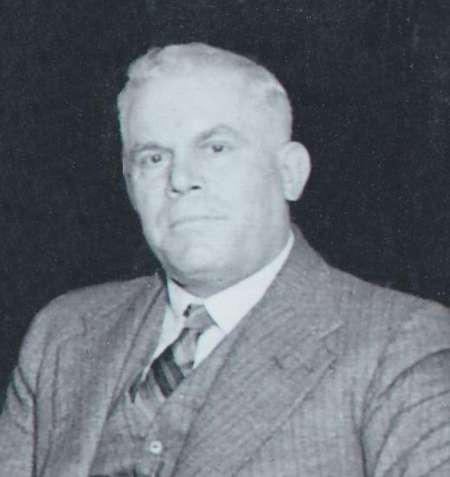
1972 – on the occasion of the 50th Anniversary of the establishment of the Kytherian Brotherhood / Association of Australia
With the help of former President of the Kytherian Association of Australia, John Prineas, and and Vassi Uhrweiss (nee, Margetis) – we can now determine that the photo attached was taken in 1972 – on the occasion of the 50th ANNIVERSARY OF THE ESTABLISHMENT OF THE Kytherian Association of Australia.
It was taken on the occasion of the 50th Anniversary Kytherian Ball.
The photograph features committee members / wives / descendants of the original committee - the founding fathers of the Kytherian Association of Australia - including one founding father - still alive at the time - Mr Bill Feros. They were announced to come forward and given a Gold commemorative medal in recognition.
The 50th Anniversary Ball program is red and gold. Copies can can be found in the KAA Library.
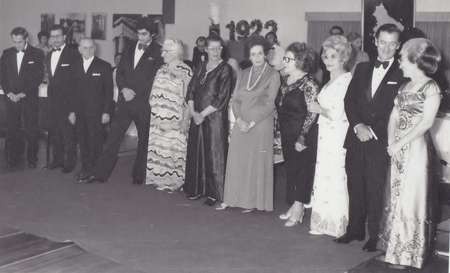
From Left to Right:
Manolis G Casimatis (Past president)
Manolis Sklavos (Later became president)
Bill Feros (Angela Comino's Father and the only founding member, and Original Secretary.)
Manolis Cassimatis and his mother. (His father was the founding president. He later became Vice-President)
Evridiki Psaltis (Wife of John, who was a foundation member)
Mrs Betty Stamel. (Her father Nick Psaltis was also foundation member)
Mrs Theodora Margetis. (Husband Bretos was a founding member.)
Aspacia Sophios (Her husband was on a later Kytherian Association Committee’s. Alec Sophios’ mother, and sister to Theodora Margetis, (nee Lianos)).
Peter Aroney (President for 11 years)
Angela Alfred (Alfieris)